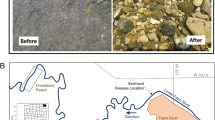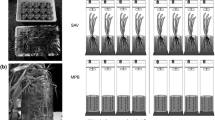Abstract
Stream macrophytes are often removed with their sediments to deepen stream channels, stabilize channel banks, or provide habitat for target species. These sediments may support enhanced nitrogen processing. To evaluate sediment nitrogen processing, identify seasonal patterns, and assess sediment processes relative to stream load, we measured denitrification and nitrification rates in a restored third- to fourth-order agricultural stream, Black Earth Creek, Wisconsin, and estimated processing over a 10 km reach. Our results show that sediments with submerged and emergent macrophytes (e.g., Potomageton spp. and Phalaris arudinacea) support greater denitrification rates than bare sediments (1.12 μmol N g−1 h−1 vs. 0.29). Sediments with macrophytes were not carbon limited and organic matter fraction was weakly correlated to denitrification. The highest denitrification potential occurred in macrophyte beds (5.19 μmol N g−1 h−1). Nitrification rates were greater in emergent beds than bare sediments (1.07 μg N ml−1day−1 vs. 0.35) with the greatest nitrification rates during the summer. Total denitrification removal in sediments with macrophytes was equivalent to 43% of the nitrate stream load (463.7 kg N day−1) during spring and nitrification in sediments with macrophytes was equivalent to 247% of summer ammonium load (3.5 kg N day−1). Although the in-channel connectivity to nitrogen rich water was limited, actual stream nitrogen loads could increase with removal of macrophytes. Macrophyte beds and supporting fringing wetted areas are important if nitrogen management is a concern for riparian stream restoration efforts.






Similar content being viewed by others
References
Alexander, G. G. & J. D. Allan, 2006. Stream restoration in the Upper Midwest, USA. Restoration Ecology 14: 595–604.
Alexander, R. B., R. A. Smith & G. E. Schwarz, 2000. Effect of stream channel size on the delivery of nitrogen to the Gulf of Mexico. Nature 403: 758–761.
Bernhardt, E. S., M. A. Palmer, J. D. Allan, G. Alexander, K. Barnas, S. Brooks, J. Carr, S. Clayton, C. Dahm, J. Follstad-Shah, D. Galat, S. Gloss, P. Goodwin, D. Hart, B. Hassett, R. Jenkinson, S. Katz, G. M. Kondolf, P. S. Lake, R. Lave, J. L. Meyer, T. K. O’Donnell, L. Pagano, B. Powell & E. Sudduth, 2005. Synthesizing U.S. river restoration efforts. Science 308: 636–637.
Bernot, M. J. & W. K. Dodds, 2005. Nitrogen retention, removal, and saturation in lotic ecosystems. Ecosystems 8: 442–453.
Bodelier, P. L. E., J. A. Libochant, C. Blom & H. J. Laanbroek, 1996. Dynamics of nitrification and denitrification in root-oxygenated sediments and adaptation of ammonia-oxidizing bacteria to low-oxygen or anoxic habitats. Applied and Environmental Microbiology 62: 4100–4107.
Bower, C. & T. Holm-Hansen, 1980. A salicylate-hypochlorite method for determining ammonia in seawater. Canadian Journal of Fisheries and Aquatic Sciences 37: 794–798.
Clarke, S. J., 2002. Vegetation growth in rivers: influences upon sediment and nutrient dynamics. Progress in Physical Geography 26: 159.
Eriksson, P. G. & S. E. B. Weisner, 1999. An experimental study on effects of submersed macrophytes on nitrification and denitrification in ammonium-rich aquatic systems. Limnology and Oceanography 44: 1993–1999.
Field, S. J. & D. J. Graczyk, 1990. Hydrology, aquatic macrophytes, and water quality of Black Earth Creek and its tributaries, Dane County, Wisconsin, 1985-86. U.S. Geological Survey Water-Resources Investigations Report 89-4089: 38.
Forshay, K. J. & E. H. Stanley, 2005. Rapid nitrate loss and denitrification in a temperate river floodplain. Biogeochemistry 75: 43–64.
Galloway, J. N. & E. B. Cowling, 2002. Nitrogen and the world. Ambio 31: 64–71.
Galloway, J. N., A. R. Townsend, J. W. Erisman, M. Bekunda, Z. C. Cai, J. R. Freney, L. A. Martinelli, S. P. Seitzinger & M. A. Sutton, 2008. Transformation of the nitrogen cycle: recent trends, questions, and potential solutions. Science 320: 889–892.
Gift, D. M., P. M. Groffman, S. S. Kaushal & P. M. Mayer, 2010. Denitrification potential, root biomass, and organic matter in degraded and restored urban riparian zones. Restoration Ecology 18: 113–120.
Gregg, W. W. & F. L. Rose, 1982. The effects of aquatic macrophytes on the stream microenvironment. Aquatic Botany 14: 309–324.
Groffman, P. M., E. A. Holland, D. D. Myrold, G. P. Robertson & X. Zou, 1999. Denitrification. In Robertson, G. P., D. C. Coleman, C. S. Bledsoe & P. Sollins (eds), Standard Methods for Long-Term Ecological Research. Oxford University Press, New York: 272–290.
Groffman, P. M., A. M. Dorsey & P. M. Mayer, 2005. N processing within geomorphic structures in urban streams. Journal of the North American Benthological Society 24: 613–625.
Haggard, B. E., E. H. Stanley & D. E. Storm, 2005. Nutrient retention in a point-source-enriched stream. Journal of the North American Benthological Society 24: 29–47.
Hernandez, M. E. & W. J. Mitsch, 2007. Denitrification potential and organic matter as affected by vegetation community, wetland age, and plant introduction in created wetlands. Journal of Environmental Quality 36: 333–342.
Holmes, R. M., J. B. Jones, S. G. Fisher & N. B. Grimm, 1996. Denitrification in a nitrogen-limited stream ecosystem. Biogeochemistry 33: 125–146.
Kaushal, S. S., P. M. Groffman, P. M. Mayer, E. Striz & A. J. Gold, 2008. Effects of stream restoration on denitrification in an urbanizing watershed. Ecological Applications 18: 789–804.
Madsen, J. D. & M. S. Adams, 1988. The seasonal biomass and productivity of the submerged macrophytes in a polluted Wisconsin stream. Freshwater Biology 20: 41–50.
Madsen, T. V. & N. Cedergreen, 2002. Sources of nutrients to rooted submerged macrophytes growing in a nutrient-rich stream. Freshwater Biology 47: 283–291.
Madsen, J. D., P. A. Chambers, W. F. James, E. W. Koch & D. F. Westlake, 2001. The interaction between water movement, sediment dynamics and submersed macrophytes. Hydrobiologia 444: 71–84.
Mayer, P., P. Groffman, E. Striz & S. Kaushal, 2010. Nitrogen dynamics at the groundwater-surface water interface of a degraded urban stream. Journal of Environmental Quality 39: 810–823.
Mosier, A. R., M. A. Bleken, P. Chaiwanakupt, E. C. Ellis, J. R. Freney, R. B. Howarth, P. A. Matson, K. Minami, R. Naylor, K. N. Weeks & Z.-l. Zhu, 2002. Policy implications of human-accelerated nitrogen cycling. Biogeochemistry 57–58: 477–516.
Mulholland, P. J., A. M. Helton, G. C. Poole, R. O. Hall, S. K. Hamilton, B. J. Peterson, J. L. Tank, L. R. Ashkenas, L. W. Cooper, C. N. Dahm, W. K. Dodds, S. E. G. Findlay, S. V. Gregory, N. B. Grimm, S. L. Johnson, W. H. McDowell, J. L. Meyer, H. M. Valett, J. R. Webster, C. P. Arango, J. J. Beaulieu, M. J. Bernot, A. J. Burgin, C. L. Crenshaw, L. T. Johnson, B. R. Niederlehner, J. M. O’Brien, J. D. Potter, R. W. Sheibley, D. J. Sobota & S. M. Thomas, 2008. Stream denitrification across biomes and its response to anthropogenic nitrate loading. Nature 452: 202–205.
O’Driscoll, M. A. & D. R. DeWalle, 2010. Seeps regulate stream nitrate concentration in a forested Appalachian catchment. Journal of Environmental Quality 39: 420–431.
Palijan, G., D. Fuks & J. Vidakovic, 2009. Spatial and temporal distribution of net nitrite and nitrate production on submersed macrophyte Ceratophyllum demersum L. Fresenius Environmental Bulletin 18: 64–69.
Peterson, B. J., W. M. Wollheim, P. J. Mulholland, J. R. Webster, J. L. Meyer, J. L. Tank, E. Marti, W. B. Bowden, H. M. Valett, A. E. Hershey, W. H. McDowell, W. K. Dodds, S. K. Hamilton, S. Gregory & D. D. Morrall, 2001. Control of nitrogen export from watersheds by headwater streams. Science 292: 86–90.
Rabalais, N. N., R. E. Turner, D. Justic, Q. Dortch, W. J. Wiseman Jr. & B. K. S. Gupta, 1996. Nutrient changes in the Mississippi River and system response on the adjacent continental shelf. Estuaries 19: 386–407.
Risgaard-Petersen, N. & K. Jensen, 1997. Nitrification and denitrification in the rhizosphere of the aquatic macrophyte Lobelia dortmanna L. Limnology and Oceanography 42: 529–537.
Royer, T. V., J. L. Tank & M. B. David, 2004. Transport and fate of nitrate in headwater agricultural streams in Illinois. Journal of Environment Quality 33: 1296–1304.
Sand-Jensen, K., 1998. Influence of submerged macrophytes on sediment composition and near-bed flow in lowland streams. Freshwater Biology 39: 663–679.
Schaller, J. L., T. V. Royer, M. B. David & J. L. Tank, 2004. Denitrification associated with plants and sediments in an agricultural stream. Journal of the North American Benthological Society 23: 667–676.
Seitzinger, S., 1988. Denitrification in freshwater and coastal marine ecosystems: ecological and geochemical significance. Limnology and Oceanography 33: 702–724.
Strauss, E. A. & G. A. Lamberti, 2000. Regulation of nitrification in aquatic sediments by organic carbon. Limnology and Oceanography 45: 1854–1859.
Strauss, E. A., N. L. Mitchell & G. A. Lamberti, 2002. Factors regulating nitrification in aquatic sediments: effects of organic carbon, nitrogen availability, and pH. Canadian Journal of Fisheries and Aquatic Sciences 59: 554–563.
Strauss, E., J. Cavanaugh, J. Heinz, W. Richardson, L. Bartsch, D. Bruesewitz, H. Imker & D. Soballe, 2004. Nitrification in the Upper Mississippi River: patterns, controls, and contribution to the NO3− budget. Journal of the North American Benthological Society 23: 1–14.
Tiedje, J. M., S. Simkins & P. M. Groffman, 1989. Perspectives on measurement of denitrification in the field including recommended protocols for acetylene based methods. Plant and Soil 115: 261–284.
Wood, E. D., 1967. Determination of Nitrate in Sea Water by Cadmium-Copper Reduction of Nitrate. Dept. of Oceanography, University of Washington, Seattle.
Young, C. L., 1981. Solubility Data Series. Oxides of Nitrogen, Vol. 8. Pergamon Press, New York.
Acknowledgments
We thank Bob Stelzer, Harry Read, Sarah Kerr, Paul Mayer, and Phil Emmling for technical assistance. Jessica Wallace, Christine Donahoe, Bridget Forshay, Francis J. Nuñez, Max Gehrman, and Jennifer Rutka provided field and lab support. The Milwaukee Zoological Society, the Summer Science Institute, and UW Department of Zoology grants provided support for this work. Notice: The research described herein was developed by the author, an employee of the U.S. Environmental Protection Agency (EPA), prior to his employment with EPA. It was conducted independent of EPA employment and has not been subjected to the Agency’s peer and administrative review. Therefore, the conclusions and opinions drawn are solely those of the author and are not necessarily the views of the Agency. Mention of trade names or commercial products does not constitute endorsement or recommendation for use.
Author information
Authors and Affiliations
Corresponding author
Additional information
Guest editors: H. J. Dumont, J. E. Havel, R. Gulati & P. Spaak / A Passion for Plankton: a tribute to the life of Stanley Dodson
Stanley I. Dodson died on 23 August 2009.
Rights and permissions
About this article
Cite this article
Forshay, K.J., Dodson, S.I. Macrophyte presence is an indicator of enhanced denitrification and nitrification in sediments of a temperate restored agricultural stream. Hydrobiologia 668, 21–34 (2011). https://doi.org/10.1007/s10750-011-0619-2
Received:
Accepted:
Published:
Issue Date:
DOI: https://doi.org/10.1007/s10750-011-0619-2




